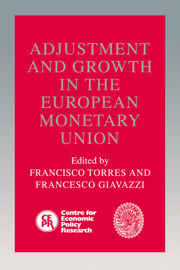Book contents
- Frontmatter
- Contents
- List of figures
- List of tables
- Preface
- List of contributors
- Foreword
- 1 Introduction
- 2 Economic and monetary union: critical notes on the Maastricht Treaty revisions
- Discussion
- 3 The design of optimal fiscal rules for Europe after 1992
- Discussion
- 4 Contracts, credibility and common knowledge: their influence on inflation convergence
- Discussion
- 5 Inflation in fixed exchange regimes: the recent Portuguese experience
- Discussion
- 6 Models of economic integration and localized growth
- Discussion
- 7 Shocking aspects of European monetary integration
- Discussion
- 8 Lessons of Massachusetts for EMU
- Discussion
- 9 Financial and currency integration in the European monetary system: the statistical record
- Discussion
- 10 Currency substitution: from the policy questions to the theory and back
- Discussion
- 11 Coordination of capital income taxes in the economic and monetary union: what needs to be done?
- Discussion
- Index
Discussion
Published online by Cambridge University Press: 29 January 2010
- Frontmatter
- Contents
- List of figures
- List of tables
- Preface
- List of contributors
- Foreword
- 1 Introduction
- 2 Economic and monetary union: critical notes on the Maastricht Treaty revisions
- Discussion
- 3 The design of optimal fiscal rules for Europe after 1992
- Discussion
- 4 Contracts, credibility and common knowledge: their influence on inflation convergence
- Discussion
- 5 Inflation in fixed exchange regimes: the recent Portuguese experience
- Discussion
- 6 Models of economic integration and localized growth
- Discussion
- 7 Shocking aspects of European monetary integration
- Discussion
- 8 Lessons of Massachusetts for EMU
- Discussion
- 9 Financial and currency integration in the European monetary system: the statistical record
- Discussion
- 10 Currency substitution: from the policy questions to the theory and back
- Discussion
- 11 Coordination of capital income taxes in the economic and monetary union: what needs to be done?
- Discussion
- Index
Summary
The problem addressed in this chapter is a fundamental problem for several countries, not just for Portugal. It is almost a ‘stylized fact’: when a high inflation country attempts to bring down inflation by fixing the exchange rate, it experiences a large and lasting appreciation of the price of non-tradable relative to traded goods. In Spain and Italy, for instance, lack of inflation convergence is attributable to a prolonged increase in the relative price of non-tradable relative to traded goods. The same was true of the Southern Cone countries during their stabilization attempts in the late 1970s and early 1980s (see World Development, 1985). Understanding why this relative price change occurs, and why it lasts for so long, is thus central to our understanding of inflation convergence in a fixed exchange rate system.
In the literature two explanations can be found for the appreciation of the relative price of non-tradables. The first and most popular one argues that the appreciation is due to some distortion: lack of credibility of the exchange rate peg (World Development, 1985), public sector wages growing too fast for non-economic reasons (CEPR, 1991), or some microeconomic rigidities in the labour market or in specific markets for non-tradables (for instance, backward-looking wage indexation in the non-tradable sectors – World Development 1985). Central to these explanations is some non-neutrality of the nominal exchange rate regime.
- Type
- Chapter
- Information
- Adjustment and Growth in the European Monetary Union , pp. 153 - 158Publisher: Cambridge University PressPrint publication year: 1993



